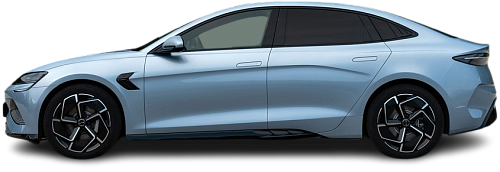USA EV Comparison: BYD Seal Design RWD vs BMW i7 eDrive50
Struggling to Decide? Let AI Help!
Your AI Summary Is Ready!
General Info
Both vehicles are currently in production. The BMW i7 eDrive50 (2023-…) has a starting price of $105700, while the BYD Seal Design RWD (2022-…) is not sold in the United States.
The two vehicles share the same body style: Sedan.
| Property | BYD Seal Design RWD | BMW i7 eDrive50 |
|---|---|---|
| Years of Production | 2022-… | 2023-… |
| Current Status | Produced | Produced |
| Country of Manufacture | China | Germany |
| Body Style | Sedan | Sedan |
| Market Availability | EU | EU, USA |
| Price USA (New) | - Price USA (New) | $105700 |
| Price USA (Used) | - Price USA (Used) | $74444 |
| GCC Score | 6.5 | 6.6 |
Range and Efficiency
While the BMW i7 eDrive50 (2023-…) offers a longer real-world range and a bigger battery, it is less energy-efficient than the BYD Seal Design RWD (2022-…).
| Property | BYD Seal Design RWD | BMW i7 eDrive50 |
|---|---|---|
| Range (EPA) | - Range (EPA) | 321 mi |
| Range (WLTP) | 354 mi | 380 mi |
| Range (GCC) | 301 mi | 316 mi |
| Battery Capacity (Nominal) | 84 kWh | 105.7 kWh |
| Battery Capacity (Usable) | 82.5 kWh | 101.7 kWh |
| Efficiency per 100 mi | 27.4 kWh/100 mi | 32.2 kWh/100 mi |
| Efficiency per kWh | 3.65 mi/kWh | 3.11 mi/kWh |
| Range and Efficiency Score | 8.2 | 7.6 |
Charging
Both vehicles utilize a standard 400-volt architecture.
The BMW i7 eDrive50 (2023-…) offers faster charging speeds at DC stations, reaching up to 200 kW, while the BYD Seal Design RWD (2022-…) maxes out at 150 kW.
Both vehicles are equipped with the same on-board charger, supporting a maximum AC charging power of 11 kW.
| Property | BYD Seal Design RWD | BMW i7 eDrive50 |
|---|---|---|
| Max Charging Power (AC) | 11 kW | 11 kW |
| Max Charging Power (DC) | 150 kW | 200 kW |
| Architecture | 400 V | 400 V |
| Charge Port | CCS Type 2 | CCS Type 1 |
| Charging Score | 6.5 | 7.2 |
Performance
Both vehicles are rear-wheel drive.
The BMW i7 eDrive50 (2023-…) boasts greater motor power and accelerates faster from 0 to 60 mph.
| Property | BYD Seal Design RWD | BMW i7 eDrive50 |
|---|---|---|
| Drive Type | RWD | RWD |
| Motor Type | PMSM | PMSM |
| Motor Power (kW) | 230 kW | 335 kW |
| Motor Power (hp) | 308 hp | 449 hp |
| Motor Torque | 266 lb-ft | 479 lb-ft |
| 0-60 mph | 5.7 s | 5.3 s |
| Top Speed | 112 mph | 127 mph |
| Performance Score | 4.5 | 5.7 |
Dimensions
The BMW i7 eDrive50 (2023-…) is longer, wider, and taller.
The BMW i7 eDrive50 (2023-…) boasts a more extended wheelbase.
| Property | BYD Seal Design RWD | BMW i7 eDrive50 |
|---|---|---|
| Length | 189 in | 212.2 in |
| Width (with Mirrors) | 84.6 in | 86.3 in |
| Width (w/o Mirrors) | 73.8 in | 76.8 in |
| Height | 57.5 in | 60.8 in |
| Wheelbase | 115 in | 126.6 in |
Cargo and Towing
A frunk (front trunk) is available in the BYD Seal Design RWD (2022-…), but the BMW i7 eDrive50 (2023-…) doesn’t have one.
The BYD Seal Design RWD (2022-…) has a towing capacity of up to 1653 lb, whereas the BMW i7 eDrive50 (2023-…) is not officially rated for towing in the US.
| Property | BYD Seal Design RWD | BMW i7 eDrive50 |
|---|---|---|
| Number of Seats | 5 | 5 |
| Curb Weight | 4597 lb | 5917 lb |
| Cargo Volume (Trunk) | 14.1 ft3 | 17.7 ft3 |
| Cargo Volume (Max) | - Cargo Volume (Max) | 17.7 ft3 |
| Cargo Volume (Frunk) | 1.9 ft3 | - Cargo Volume (Frunk) |
| Towing Capacity | 1653 lb | - Towing Capacity |
| Cargo and Towing Score | 5.3 | 5.7 |




